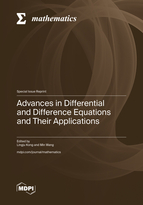Advances in Differential and Difference Equations and Their Applications
A special issue of Mathematics (ISSN 2227-7390). This special issue belongs to the section "C1: Difference and Differential Equations".
Deadline for manuscript submissions: closed (31 May 2024) | Viewed by 17969
Special Issue Editors
Interests: differential and difference equations; boundary value problems; critical point theory
Special Issue Information
Dear Colleagues,
We are editing this Special Issue, “Advances in Differential and Difference Equations and Their Applications”, for the journal of Mathematics with the goal of reporting the latest developments and achievements in related research areas. Our aim is to bring together senior and young researchers to publish their original research articles on differential and difference equations and their many real-world applications.
Topics of interest include, but are not limited to:
- Existence theory in boundary and initial value problems.
- Spectral theory.
- Stability theory.
- Complex networks.
- Stochastic/deterministic models.
- Fractional calculus and differential equations.
- Qualitative analysis of solutions.
- Mathematical modeling.
- Applications for real-world problems.
We cordially invite you to contribute a paper to this Special Issue.
Prof. Dr. Lingju Kong
Dr. Min Wang
Guest Editors
Manuscript Submission Information
Manuscripts should be submitted online at www.mdpi.com by registering and logging in to this website. Once you are registered, click here to go to the submission form. Manuscripts can be submitted until the deadline. All submissions that pass pre-check are peer-reviewed. Accepted papers will be published continuously in the journal (as soon as accepted) and will be listed together on the special issue website. Research articles, review articles as well as short communications are invited. For planned papers, a title and short abstract (about 100 words) can be sent to the Editorial Office for announcement on this website.
Submitted manuscripts should not have been published previously, nor be under consideration for publication elsewhere (except conference proceedings papers). All manuscripts are thoroughly refereed through a single-blind peer-review process. A guide for authors and other relevant information for submission of manuscripts is available on the Instructions for Authors page. Mathematics is an international peer-reviewed open access semimonthly journal published by MDPI.
Please visit the Instructions for Authors page before submitting a manuscript. The Article Processing Charge (APC) for publication in this open access journal is 2600 CHF (Swiss Francs). Submitted papers should be well formatted and use good English. Authors may use MDPI's English editing service prior to publication or during author revisions.
Keywords
- boundary value problems
- initial value problems
- existence and uniqueness of solutions
- eigenvalue problems
- models
- stability analysis
Benefits of Publishing in a Special Issue
- Ease of navigation: Grouping papers by topic helps scholars navigate broad scope journals more efficiently.
- Greater discoverability: Special Issues support the reach and impact of scientific research. Articles in Special Issues are more discoverable and cited more frequently.
- Expansion of research network: Special Issues facilitate connections among authors, fostering scientific collaborations.
- External promotion: Articles in Special Issues are often promoted through the journal's social media, increasing their visibility.
- e-Book format: Special Issues with more than 10 articles can be published as dedicated e-books, ensuring wide and rapid dissemination.
Further information on MDPI's Special Issue policies can be found here.







